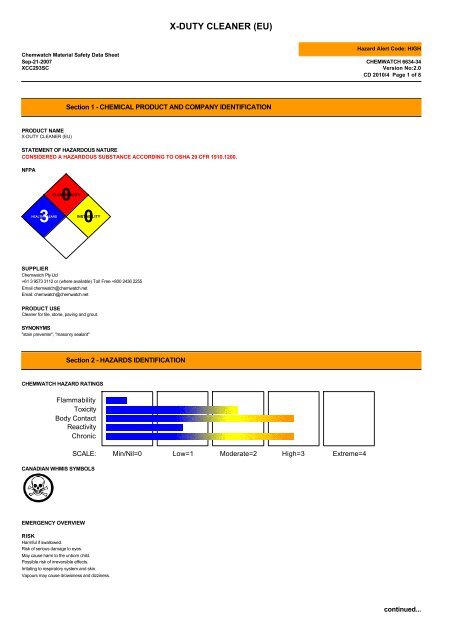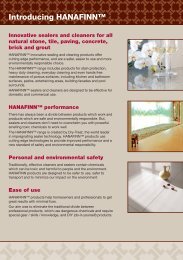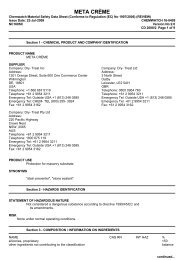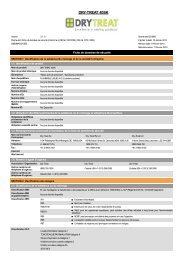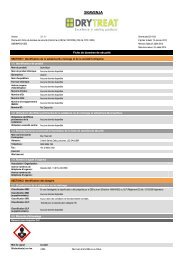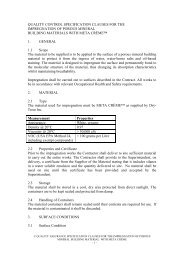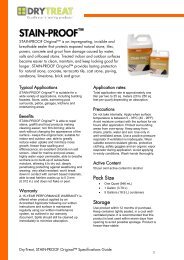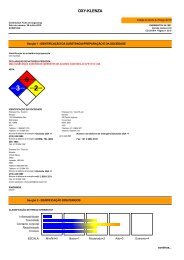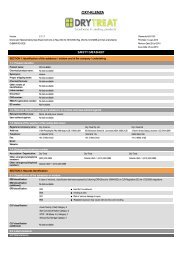Chemwatch MSDS Print - Dry Treat
Chemwatch MSDS Print - Dry Treat
Chemwatch MSDS Print - Dry Treat
You also want an ePaper? Increase the reach of your titles
YUMPU automatically turns print PDFs into web optimized ePapers that Google loves.
X-DUTY CLEANER (EU)<br />
Hazard Alert Code: HIGH<br />
<strong>Chemwatch</strong> Material Safety Data Sheet<br />
Sep-21-2007 CHEMWATCH 6634-34<br />
XCC293SC Version No:2.0<br />
CD 2010/4 Page 1 of 8<br />
PRODUCT NAME<br />
X-DUTY CLEANER (EU)<br />
Section 1 - CHEMICAL PRODUCT AND COMPANY IDENTIFICATION<br />
STATEMENT OF HAZARDOUS NATURE<br />
CONSIDERED A HAZARDOUS SUBSTANCE ACCORDING TO OSHA 29 CFR 1910.1200.<br />
NFPA<br />
HEALTH HAZARD 3<br />
FLAMMABILITY 0<br />
INSTABILITY 0<br />
SUPPLIER<br />
<strong>Chemwatch</strong> Pty Ltd<br />
+61 3 9573 3112 or (where available) Toll Free +800 2436 2255<br />
Email chemwatch@chemwatch.net<br />
Email: chemwatch@chemwatch.net<br />
PRODUCT USE<br />
Cleaner for tile, stone, paving and grout.<br />
SYNONYMS<br />
"stain preventer", "masonry sealant"<br />
CHEMWATCH HAZARD RATINGS<br />
Section 2 - HAZARDS IDENTIFICATION<br />
Flammability<br />
Toxicity<br />
Body Contact<br />
Reactivity<br />
Chronic<br />
CANADIAN WHMIS SYMBOLS<br />
EMERGENCY OVERVIEW<br />
RISK<br />
Harmful if swallowed.<br />
Risk of serious damage to eyes.<br />
May cause harm to the unborn child.<br />
Possible risk of irreversible effects.<br />
Irritating to respiratory system and skin.<br />
Vapours may cause drowsiness and dizziness.<br />
SCALE: Min/Nil=0 Low=1 Moderate=2 High=3 Extreme=4<br />
continued...
X-DUTY CLEANER (EU)<br />
Hazard Alert Code: HIGH<br />
<strong>Chemwatch</strong> Material Safety Data Sheet<br />
Sep-21-2007 CHEMWATCH 6634-34<br />
XCC293SC Version No:2.0<br />
CD 2010/4 Page 2 of 8<br />
Section 2 - HAZARDS IDENTIFICATION<br />
POTENTIAL HEALTH EFFECTS<br />
GHS Hazard Phrases<br />
.<br />
May cause respiratory irritation<br />
May cause drowsiness or dizziness<br />
Harmful if swallowed<br />
May cause allergic or asthmatic symptoms or breathing difficulties if inhaled<br />
May cause allergic skin reaction<br />
May cause genetic defects<br />
May damage the unborn child<br />
Causes serious eye damage<br />
Causes skin irritation<br />
Causes serious eye damage<br />
Section 3 - COMPOSITION / INFORMATION ON INGREDIENTS<br />
NAME CAS RN %<br />
gamma- butyrolactone 96-48-0 30-60<br />
N- methyl- 2- pyrrolidone 872-50-4 10-30<br />
other ingredients not contributing to the classification balance<br />
SWALLOWED<br />
• If swallowed do NOT induce vomiting.<br />
Section 4 - FIRST AID MEASURES<br />
• If vomiting occurs, lean patient forward or place on left side (head-down position, if possible) to maintain open airway and prevent aspiration.<br />
• Observe the patient carefully.<br />
• Never give liquid to a person showing signs of being sleepy or with reduced awareness; i.e. becoming unconscious.<br />
• Give water to rinse out mouth, then provide liquid slowly and as much as casualty can comfortably drink.<br />
• Seek medical advice.<br />
EYE<br />
■ If this product comes in contact with the eyes:<br />
• Immediately hold eyelids apart and flush the eye continuously with running water.<br />
• Ensure complete irrigation of the eye by keeping eyelids apart and away from eye and moving the eyelids by occasionally lifting the upper and lower<br />
lids.<br />
• Continue flushing until advised to stop by the Poisons Information Centre or a doctor, or for at least 15 minutes.<br />
• Transport to hospital or doctor without delay.<br />
• Removal of contact lenses after an eye injury should only be undertaken by skilled personnel.<br />
SKIN<br />
■ If skin contact occurs:<br />
• Immediately remove all contaminated clothing, including footwear.<br />
• Flush skin and hair with running water (and soap if available).<br />
• Seek medical attention in event of irritation.<br />
INHALED<br />
• If fumes or combustion products are inhaled remove from contaminated area.<br />
• Other measures are usually unnecessary.<br />
NOTES TO PHYSICIAN<br />
■ <strong>Treat</strong> symptomatically.<br />
Vapour Pressure (mmHG): Not Available<br />
Upper Explosive Limit (%): Not Applicable<br />
Specific Gravity (water=1): 0.90<br />
Lower Explosive Limit (%): Not Applicable<br />
EXTINGUISHING MEDIA<br />
• Water spray or fog.<br />
• Foam.<br />
• <strong>Dry</strong> chemical powder.<br />
• BCF (where regulations permit).<br />
• Carbon dioxide.<br />
Section 5 - FIRE FIGHTING MEASURES<br />
continued...
X-DUTY CLEANER (EU)<br />
Hazard Alert Code: HIGH<br />
<strong>Chemwatch</strong> Material Safety Data Sheet<br />
Sep-21-2007 CHEMWATCH 6634-34<br />
XCC293SC Version No:2.0<br />
CD 2010/4 Page 3 of 8<br />
Section 5 - FIRE FIGHTING MEASURES<br />
FIRE FIGHTING<br />
• Alert Fire Brigade and tell them location and nature of hazard.<br />
• Wear breathing apparatus plus protective gloves.<br />
• Prevent, by any means available, spillage from entering drains or water courses.<br />
• Use water delivered as a fine spray to control fire and cool adjacent area.<br />
• DO NOT approach containers suspected to be hot.<br />
• Cool fire exposed containers with water spray from a protected location.<br />
• If safe to do so, remove containers from path of fire.<br />
• Equipment should be thoroughly decontaminated after use.<br />
GENERAL FIRE HAZARDS/HAZARDOUS COMBUSTIBLE PRODUCTS<br />
• The material is not readily combustible under normal conditions.<br />
• However, it will break down under fire conditions and the organic component may burn.<br />
• Not considered to be a significant fire risk.<br />
• Heat may cause expansion or decomposition with violent rupture of containers.<br />
• Decomposes on heating and may produce toxic fumes of carbon monoxide (CO).<br />
• May emit acrid smoke.<br />
Combustion products include: carbon dioxide (CO2), nitrogen oxides (NOx), sulfur oxides (SOx), other pyrolysis products typical of burning organic<br />
material.<br />
May emit poisonous fumes.<br />
May emit corrosive fumes.<br />
FIRE INCOMPATIBILITY<br />
• Avoid contamination with oxidising agents i.e. nitrates, oxidising acids, chlorine bleaches, pool chlorine etc. as ignition may result.<br />
Personal Protective Equipment<br />
Gas tight chemical resistant suit.<br />
Limit exposure duration to 1 BA set 30 mins.<br />
MINOR SPILLS<br />
■ Slippery when spilt.<br />
• Remove all ignition sources.<br />
• Clean up all spills immediately.<br />
Section 6 - ACCIDENTAL RELEASE MEASURES<br />
• Avoid breathing vapours and contact with skin and eyes.<br />
• Control personal contact by using protective equipment.<br />
• Contain and absorb spill with sand, earth, inert material or vermiculite.<br />
• Wipe up.<br />
• Place in a suitable, labelled container for waste disposal.<br />
MAJOR SPILLS<br />
■ Slippery when spilt.<br />
Moderate hazard.<br />
• Clear area of personnel and move upwind.<br />
• Alert Fire Brigade and tell them location and nature of hazard.<br />
• Wear breathing apparatus plus protective gloves.<br />
• Prevent, by any means available, spillage from entering drains or water course.<br />
• No smoking, naked lights or ignition sources.<br />
• Increase ventilation.<br />
• Stop leak if safe to do so.<br />
• Contain spill with sand, earth or vermiculite.<br />
• Collect recoverable product into labelled containers for recycling.<br />
• Absorb remaining product with sand, earth or vermiculite.<br />
• Collect solid residues and seal in labelled drums for disposal.<br />
• Wash area and prevent runoff into drains.<br />
• If contamination of drains or waterways occurs, advise emergency services.<br />
Section 7 - HANDLING AND STORAGE<br />
PROCEDURE FOR HANDLING<br />
• DO NOT allow clothing wet with material to stay in contact with skin.<br />
• Avoid all personal contact, including inhalation.<br />
• Wear protective clothing when risk of exposure occurs.<br />
• Use in a well-ventilated area.<br />
• Prevent concentration in hollows and sumps.<br />
• DO NOT enter confined spaces until atmosphere has been checked.<br />
• DO NOT allow material to contact humans, exposed food or food utensils.<br />
continued...
X-DUTY CLEANER (EU)<br />
Hazard Alert Code: HIGH<br />
<strong>Chemwatch</strong> Material Safety Data Sheet<br />
Sep-21-2007 CHEMWATCH 6634-34<br />
XCC293SC Version No:2.0<br />
CD 2010/4 Page 4 of 8<br />
Section 7 - HANDLING AND STORAGE<br />
• Avoid contact with incompatible materials.<br />
• When handling, DO NOT eat, drink or smoke.<br />
• Keep containers securely sealed when not in use.<br />
• Avoid physical damage to containers.<br />
• Always wash hands with soap and water after handling.<br />
• Work clothes should be laundered separately. Launder contaminated clothing before re-use.<br />
• Use good occupational work practice.<br />
• Observe manufacturer's storing and handling recommendations.<br />
• Atmosphere should be regularly checked against established exposure standards to ensure safe working conditions are maintained.<br />
RECOMMENDED STORAGE METHODS<br />
• Metal can or drum<br />
• Packaging as recommended by manufacturer.<br />
• Check all containers are clearly labelled and free from leaks.<br />
STORAGE REQUIREMENTS<br />
• Store in original containers.<br />
• Keep containers securely sealed.<br />
• No smoking, naked lights or ignition sources.<br />
• Store in a cool, dry, well-ventilated area.<br />
• Store away from incompatible materials and foodstuff containers.<br />
• Protect containers against physical damage and check regularly for leaks.<br />
• Observe manufacturer's storing and handling recommendations.<br />
Section 8 - EXPOSURE CONTROLS / PERSONAL PROTECTION<br />
EXPOSURE CONTROLS<br />
Source Material TWA ppm TWA STEL STEL Peak Peak TWA Notes<br />
mg/m³ ppm mg/m³ ppm mg/m³ F/CC<br />
___________ ___________ _______ _______ _______ _______ _______ _______ _______ _______<br />
Canada - Ontario N- methyl- 2- 400<br />
Occupational pyrrolidone (N-<br />
Exposure Limits Methyl- 2-<br />
pyrrolidone)<br />
US AIHA Workplace N- methyl- 2- 10 skin<br />
Environmental pyrrolidone (n-<br />
Exposure Levels Methyl- 2-<br />
(WEELs) Pyrrolidone [a])<br />
Canada - Yukon N- methyl- 2- 100 400 125 500<br />
Permissible pyrrolidone (N-<br />
Concentrations Methyl- 2for<br />
Airborne pyrrolidone)<br />
Contaminant<br />
Substances<br />
The following materials had no OELs on our records<br />
• gamma- butyrolactone: CAS:96- 48- 0<br />
PERSONAL PROTECTION<br />
RESPIRATOR<br />
Type AK-P Filter of sufficient capacity<br />
EYE<br />
• Safety glasses with side shields.<br />
• Chemical goggles.<br />
• Contact lenses may pose a special hazard; soft contact lenses may absorb and concentrate irritants. A written policy document, describing the<br />
wearing of lens or restrictions on use, should be created for each workplace or task. This should include a review of lens absorption and<br />
adsorption for the class of chemicals in use and an account of injury experience. Medical and first-aid personnel should be trained in their<br />
removal and suitable equipment should be readily available. In the event of chemical exposure, begin eye irrigation immediately and remove contact<br />
lens as soon as practicable. Lens should be removed at the first signs of eye redness or irritation - lens should be removed in a clean environment<br />
only after workers have washed hands thoroughly. [CDC NIOSH Current Intelligence Bulletin 59].<br />
continued...
X-DUTY CLEANER (EU)<br />
Hazard Alert Code: HIGH<br />
<strong>Chemwatch</strong> Material Safety Data Sheet<br />
Sep-21-2007 CHEMWATCH 6634-34<br />
XCC293SC Version No:2.0<br />
CD 2010/4 Page 5 of 8<br />
Section 8 - EXPOSURE CONTROLS / PERSONAL PROTECTION<br />
HANDS/FEET<br />
• Wear chemical protective gloves, eg. PVC.<br />
• Wear safety footwear or safety gumboots, eg. Rubber.<br />
NOTE:<br />
• The material may produce skin sensitisation in predisposed individuals. Care must be taken, when removing gloves and other protective equipment, to<br />
avoid all possible skin contact.<br />
• Contaminated leather items, such as shoes, belts and watch-bands should be removed and destroyed.<br />
Suitability and durability of glove type is dependent on usage. Important factors in the selection of gloves include: such as:<br />
• frequency and duration of contact,<br />
• chemical resistance of glove material,<br />
• glove thickness and<br />
• dexterity<br />
Select gloves tested to a relevant standard (e.g. Europe EN 374, US F739).<br />
• When prolonged or frequently repeated contact may occur, a glove with a protection class of 5 or higher (breakthrough time greater than 240 minutes<br />
according to EN 374) is recommended.<br />
• When only brief contact is expected, a glove with a protection class of 3 or higher (breakthrough time greater than 60 minutes according to EN 374)<br />
is recommended.<br />
• Contaminated gloves should be replaced.<br />
Gloves must only be worn on clean hands. After using gloves, hands should be washed and dried thoroughly. Application of a non-perfumed moisturiser<br />
is recommended.<br />
OTHER<br />
• Overalls.<br />
• P.V.C. apron.<br />
• Barrier cream.<br />
• Skin cleansing cream.<br />
• Eye wash unit.<br />
ENGINEERING CONTROLS<br />
■ General exhaust is adequate under normal operating conditions. Local exhaust ventilation may be required in specific circumstances. If risk of<br />
overexposure exists, wear approved respirator. Correct fit is essential to obtain adequate protection. Provide adequate ventilation in warehouse or<br />
closed storage areas.<br />
PHYSICAL PROPERTIES<br />
Liquid.<br />
Mixes with water.<br />
Section 9 - PHYSICAL AND CHEMICAL PROPERTIES<br />
State Liquid Molecular Weight Not Applicable<br />
Melting Range (°F) Not Available Viscosity Not Available<br />
Boiling Range (°F) Not Available Solubility in water (g/L) Miscible<br />
Flash Point (°F) Not Applicable pH (1% solution) Not Available<br />
Decomposition Temp (°F) Not Available pH (as supplied) Not Available<br />
Autoignition Temp (°F) Not Applicable Vapour Pressure (mmHG) Not Available<br />
Upper Explosive Limit (%) Not Applicable Specific Gravity (water=1) 0.90<br />
Lower Explosive Limit (%) Not Applicable Relative Vapour Density Not Available<br />
(air=1)<br />
Volatile Component (%vol) Not Available Evaporation Rate Not Available<br />
APPEARANCE<br />
Clear liquid with a characteristic odour; dispersible in water.<br />
Section 10 - CHEMICAL STABILITY<br />
CONDITIONS CONTRIBUTING TO INSTABILITY<br />
• Presence of incompatible materials.<br />
• Product is considered stable.<br />
• Hazardous polymerisation will not occur.<br />
STORAGE INCOMPATIBILITY<br />
• Avoid reaction with oxidising agents.<br />
For incompatible materials - refer to Section 7 - Handling and Storage.<br />
continued...
X-DUTY CLEANER (EU)<br />
Hazard Alert Code: HIGH<br />
<strong>Chemwatch</strong> Material Safety Data Sheet<br />
Sep-21-2007 CHEMWATCH 6634-34<br />
XCC293SC Version No:2.0<br />
CD 2010/4 Page 6 of 8<br />
X-DUTY CLEANER (EU)<br />
Section 11 - TOXICOLOGICAL INFORMATION<br />
TOXICITY AND IRRITATION<br />
■ The material may produce severe irritation to the eye causing pronounced inflammation. Repeated or prolonged exposure to irritants may produce<br />
conjunctivitis.<br />
No data<br />
Section 12 - ECOLOGICAL INFORMATION<br />
Ecotoxicity<br />
Ingredient Persistence: Persistence: Air Bioaccumulation Mobility<br />
Water/Soil<br />
gamma- butyrolactone LOW LOW HIGH<br />
N- methyl- 2- pyrrolidone LOW LOW HIGH<br />
Section 13 - DISPOSAL CONSIDERATIONS<br />
Disposal Instructions<br />
All waste must be handled in accordance with local, state and federal regulations.<br />
• Containers may still present a chemical hazard/ danger when empty.<br />
• Return to supplier for reuse/ recycling if possible.<br />
Otherwise:<br />
• If container can not be cleaned sufficiently well to ensure that residuals do not remain or if the container cannot be used to store the same<br />
product, then puncture containers, to prevent re-use, and bury at an authorised landfill.<br />
• Where possible retain label warnings and <strong>MSDS</strong> and observe all notices pertaining to the product.<br />
Legislation addressing waste disposal requirements may differ by country, state and/ or territory. Each user must refer to laws operating in their<br />
area. In some areas, certain wastes must be tracked.<br />
A Hierarchy of Controls seems to be common - the user should investigate:<br />
• Reduction<br />
• Reuse<br />
• Recycling<br />
• Disposal (if all else fails)<br />
This material may be recycled if unused, or if it has not been contaminated so as to make it unsuitable for its intended use. If it has been<br />
contaminated, it may be possible to reclaim the product by filtration, distillation or some other means. Shelf life considerations should also be<br />
applied in making decisions of this type. Note that properties of a material may change in use, and recycling or reuse may not always be appropriate.<br />
• DO NOT allow wash water from cleaning or process equipment to enter drains.<br />
• It may be necessary to collect all wash water for treatment before disposal.<br />
• In all cases disposal to sewer may be subject to local laws and regulations and these should be considered first.<br />
• Where in doubt contact the responsible authority.<br />
• Recycle wherever possible or consult manufacturer for recycling options.<br />
• Consult State Land Waste Authority for disposal.<br />
• Bury or incinerate residue at an approved site.<br />
• Recycle containers if possible, or dispose of in an authorised landfill.<br />
Section 14 - TRANSPORTATION INFORMATION<br />
NOT REGULATED FOR TRANSPORT OF DANGEROUS GOODS: DOT, IATA, IMDG<br />
Section 15 - REGULATORY INFORMATION<br />
continued...
X-DUTY CLEANER (EU)<br />
Hazard Alert Code: HIGH<br />
<strong>Chemwatch</strong> Material Safety Data Sheet<br />
Sep-21-2007 CHEMWATCH 6634-34<br />
XCC293SC Version No:2.0<br />
CD 2010/4 Page 7 of 8<br />
Section 15 - REGULATORY INFORMATION<br />
REGULATIONS<br />
ND<br />
Ingredient CAS % de minimus concentration<br />
N-methyl-2-pyrrolidone 872-50-4 1.0<br />
Regulations for ingredients<br />
gamma-butyrolactone (CAS: 96-48-0) is found on the following regulatory lists;<br />
"GESAMP/EHS Composite List - GESAMP Hazard Profiles","IMO IBC Code Chapter 17: Summary of minimum requirements","IMO MARPOL 73/78 (Annex II) - List<br />
of Noxious Liquid Substances Carried in Bulk","International Agency for Research on Cancer (IARC) - Agents Reviewed by the IARC Monographs",<br />
"International Council of Chemical Associations (ICCA) - High Production Volume List","International Fragrance Association (IFRA) Survey:<br />
Transparency List","OECD Representative List of High Production Volume (HPV) Chemicals","US - Alabama Precursor Chemicals","US DOE Temporary<br />
Emergency Exposure Limits (TEELs)","US DOT Coast Guard Bulk Hazardous Materials - List of Flammable and Combustible Bulk Liquid Cargoes","US Drug<br />
Enforcement Administration (DEA) List I and II Regulated Chemicals","US EPA High Production Volume Program Chemical List","US Food Additive Database",<br />
"US Toxic Substances Control Act (TSCA) - Inventory"<br />
N-methyl-2-pyrrolidone (CAS: 872-50-4,26138-58-9) is found on the following regulatory lists;<br />
"Canada - Ontario Occupational Exposure Limits","Canada - Yukon Permissible Concentrations for Airborne Contaminant Substances","Canada National<br />
Pollutant Release Inventory (NPRI)","Canada Toxicological Index Service - Workplace Hazardous Materials Information System - WHMIS (English)",<br />
"GESAMP/EHS Composite List - GESAMP Hazard Profiles","IMO IBC Code Chapter 17: Summary of minimum requirements","IMO MARPOL 73/78 (Annex II) - List<br />
of Noxious Liquid Substances Carried in Bulk","International Council of Chemical Associations (ICCA) - High Production Volume List","OECD<br />
Representative List of High Production Volume (HPV) Chemicals","US - California Proposition 65 - Maximum Allowable Dose Levels (MADLs) for Chemicals<br />
Causing Reproductive Toxicity","US - California Proposition 65 - Reproductive Toxicity","US - Maine Chemicals of High Concern List","US - Minnesota<br />
Hazardous Substance List","US - Pennsylvania - Hazardous Substance List","US AIHA Workplace Environmental Exposure Levels (WEELs)","US DOE Temporary<br />
Emergency Exposure Limits (TEELs)","US DOT Coast Guard Bulk Hazardous Materials - List of Flammable and Combustible Bulk Liquid Cargoes","US EPA High<br />
Production Volume Program Chemical List","US EPA Master Testing List - Index I Chemicals Listed","US EPCRA Section 313 Chemical List","US List of<br />
Lists - Consolidated List of Chemicals Subject to EPCRA, CERCLA and Section 112(r) of the Clean Air Act","US Toxic Substances Control Act (TSCA) -<br />
Inventory","US TSCA Section 4 - Chemicals Subject to Testing Consent Orders","US TSCA Section 4/12 (b) - Sunset Date/Status"<br />
No data for X-Duty Cleaner (EU) (CW: 6634-34)<br />
Section 16 - OTHER INFORMATION<br />
LIMITED EVIDENCE<br />
#Regulations for ingredients<br />
#gamma- butyrolactone (CAS: 96- 48- 0) is found on the following regulatory<br />
lists;<br />
" GESAMP/EHS Composite List - GESAMP Hazard Profiles" , " IMO IBC Code Chapter<br />
17: Summary of minimum requirements" , " IMO MARPOL 73/78 (Annex II) - List of<br />
Noxious Liquid Substances Carried in Bulk" , " International Agency for Research<br />
on Cancer (IARC) - Agents Reviewed by the IARC Monographs" , " International<br />
Council of Chemical Associations (ICCA) - High Production Volume List" , "<br />
International Fragrance Association (IFRA) Survey: Transparency List" , " OECD<br />
Representative List of High Production Volume (HPV) Chemicals" , " US - Alabama<br />
Precursor Chemicals" , " US DOE Temporary Emergency Exposure Limits (TEELs)" , "<br />
US DOT Coast Guard Bulk Hazardous Materials - List of Flammable and Combustible<br />
Bulk Liquid Cargoes" , " US Drug Enforcement Administration (DEA) List I and II<br />
Regulated Chemicals" , " US EPA High Production Volume Program Chemical List" ,<br />
" US Food Additive Database" , " US Toxic Substances Control Act (TSCA) -<br />
Inventory"<br />
#N- methyl- 2- pyrrolidone (CAS: 872- 50- 4, 26138- 58- 9) is found on the<br />
following regulatory lists;<br />
" Canada - Ontario Occupational Exposure Limits" , " Canada - Yukon Permissible<br />
Concentrations for Airborne Contaminant Substances" , " Canada National<br />
Pollutant Release Inventory (NPRI)" , " Canada Toxicological Index Service -<br />
Workplace Hazardous Materials Information System - WHMIS (English)" , "<br />
GESAMP/EHS Composite List - GESAMP Hazard Profiles" , " IMO IBC Code Chapter 17:<br />
Summary of minimum requirements" , " IMO MARPOL 73/78 (Annex II) - List of<br />
Noxious Liquid Substances Carried in Bulk" , " International Council of Chemical<br />
Associations (ICCA) - High Production Volume List" , " OECD Representative List<br />
of High Production Volume (HPV) Chemicals" , " US - California Proposition 65 -<br />
Maximum Allowable Dose Levels (MADLs) for Chemicals Causing Reproductive<br />
Toxicity" , " US - California Proposition 65 - Reproductive Toxicity" , " US -<br />
Maine Chemicals of High Concern List" , " US - Minnesota Hazardous Substance<br />
List" , " US - Pennsylvania - Hazardous Substance List" , " US AIHA Workplace<br />
Environmental Exposure Levels (WEELs)" , " US DOE Temporary Emergency Exposure<br />
Limits (TEELs)" , " US DOT Coast Guard Bulk Hazardous Materials - List of<br />
Flammable and Combustible Bulk Liquid Cargoes" , " US EPA High Production Volume<br />
Program Chemical List" , " US EPA Master Testing List - Index I Chemicals<br />
continued...
X-DUTY CLEANER (EU)<br />
Hazard Alert Code: HIGH<br />
<strong>Chemwatch</strong> Material Safety Data Sheet<br />
Sep-21-2007 CHEMWATCH 6634-34<br />
XCC293SC Version No:2.0<br />
CD 2010/4 Page 8 of 8<br />
Section 16 - OTHER INFORMATION<br />
Listed" , " US EPCRA Section 313 Chemical List" , " US List of Lists -<br />
Consolidated List of Chemicals Subject to EPCRA, CERCLA and Section 112(r) of<br />
the Clean Air Act" , " US Toxic Substances Control Act (TSCA) - Inventory" , "<br />
US TSCA Section 4 - Chemicals Subject to Testing Consent Orders" , " US TSCA<br />
Section 4/12 (b) - Sunset Date/Status"<br />
#No data for X- Duty Cleaner (EU) (CW: 6634- 34)<br />
ND<br />
Substance CAS Suggested codes<br />
gamma- butyrolactone 96- 48- 0<br />
INGREDIENTS WITH MULTIPLE CAS NUMBERS<br />
Ingredient Name CAS<br />
N-methyl-2-pyrrolidone 872-50-4, 26138-58-9<br />
■ Classification of the preparation and its individual components has drawn on official and authoritative sources as well as independent review by<br />
the <strong>Chemwatch</strong> Classification committee using available literature references.<br />
A list of reference resources used to assist the committee may be found at:<br />
www.chemwatch.net/references.<br />
■ The (M)SDS is a Hazard Communication tool and should be used to assist in the Risk Assessment. Many factors determine whether the reported Hazards<br />
are Risks in the workplace or other settings. Risks may be determined by reference to Exposures Scenarios. Scale of use, frequency of use and current<br />
or available engineering controls must be considered.<br />
■ For detailed advice on Personal Protective Equipment, refer to the following U.S. Regulations and Standards:<br />
OSHA Standards - 29 CFR:<br />
1910.132 - Personal Protective Equipment - General requirements<br />
1910.133 - Eye and face protection<br />
1910.134 - Respiratory Protection<br />
1910.136 - Occupational foot protection<br />
1910.138 - Hand Protection<br />
Eye and face protection - ANSI Z87.1<br />
Foot protection - ANSI Z41<br />
Respirators must be NIOSH approved.<br />
This document is copyright. Apart from any fair dealing for the purposes of private study, research, review or<br />
criticism, as permitted under the Copyright Act, no part may be reproduced by any process without written<br />
permission from CHEMWATCH. TEL (+61 3) 9572 4700.<br />
Issue Date: Sep-21-2007<br />
<strong>Print</strong> Date: Jan-12-2011


